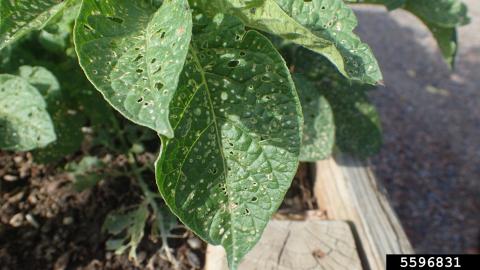How do I get rid of flea beetles in my vegetable garden?

If some of the plants in your vegetable garden are riddled with small holes, there is a good chance you have flea beetles. Flea beetles are a group of small leaf beetles that range in size from 1/16 to 1/8 of an inch long, in various shades of black, bronze, brown, blue and gray, depending on species. They are so named because they have large, powerful hind legs and can jump when they are disturbed.
Different species of flea beetles feed on different garden plants. Some species attack eggplant and related plants (such as potatoes and tomatoes), while others primarily eat broccoli or other brassicas. Vegetable plants that commonly see flea beetle damage include: beans, potatoes, tomatoes, radishes, broccoli, peppers, spinach, melons, turnips and eggplant, not to mention a wide variety of common weeds.
Life Cycle
Flea beetles overwinter in leaf litter or wooded areas and emerge in early spring to begin feeding on their preferred host plant. The adult beetles mate and lay eggs in the soil nearby and, when the eggs hatch, the developing larvae feed on plant roots and underground stems. After a short pupation, the beetles emerge from the soil as adults and begin feeding on nearby plants.
Damage
Flea beetle damage is very distinctive and, once you know what to look for, it is hard to confuse with anything else. Adult flea beetles feed on plant leaves and stems, and create shallow pits and holes in leaves that are roughly circular and no more than 1/8 of an inch in diameter. Leaves that have suffered heavy feeding injury have a “shot hole,” or sieve-like look to their foliage.
Though feeding damage often looks serious, it is often not as critical to plant health as it may appear, especially if the vegetable plants are well established. Direct sown seedlings are more vulnerable to flea beetles than larger transplants because they have less leaf surface area to lose. Flea beetle damage tends to be at its worst in the spring and early summer and decreases as the season goes along.
Management
Flea beetles can usually be managed effectively by using an integrated pest management approach. Start by focusing on controlling weeds in and around the garden. Many common weeds in the vegetable garden can attract flea beetles from surrounding areas in the landscape. Removing as much crop debris at the end of the season as possible helps reduce overwintering habitat.
Flea beetle infestations can often seemingly come out of nowhere, so it is very important to monitor your vegetable garden frequently, especially when seedlings are still small. Because flea beetles are so small and fast, they are incredibly difficult to remove by hand, like so many other vegetable insect pests.
If flea beetles have been a serious issue in the past, some gardeners like to use row covers to keep the insects off their young plants while they are at their most vulnerable. Row covers can be removed just before plants begin flowering to allow insect pollinators in. For foliage crops like kale and spinach that don’t require insect pollination, it may make sense to leave the row covers in place until the plants are ready for harvest.
When flea beetle numbers are high enough to threaten serious injury to plants, insecticides serve as the last means of defense. A spray is often only necessary on seedlings that have lost more than a third of their leaf surface area.
There are many insecticides labelled for use against flea beetles in vegetable plantings that contain active ingredients such as spinosad, carbaryl, zeta-cypermethrin and pyrethrins. A single application may not be enough to significantly reduce flea beetle populations, because the insects are extremely mobile and promptly reinvade crops.
If you decide to use a chemical approach, make sure to carefully read and follow all instructions on the product label. Pay particular attention to whether the insecticide is registered for use on the crop you are growing and for controlling flea beetles.
Got questions? The Ask UNH Extension Infoline offers practical help finding answers for your home, yard, and garden questions. Call toll free at 1-877-398-4769, Monday to Friday, 9 a.m. to 2 p.m., or e-mail us at answers@unh.edu.
Related Resource(s)
Do you love learning about stuff like this?
SUBSCRIBE TO Granite State Gardening newsletter
Got questions? The UNH Extension Yard and Garden Infoline offers practical help finding answers for your yard and garden questions.
Call toll free at 1-877-398-4769, Monday to Friday, 9 a.m. to 2 p.m., or fill out webform.
